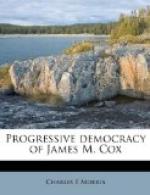“Since the adoption of the law there have been 300,000 industrial accidents and only seventeen suits have been brought against employers who paid into the state insurance fund. There was but one single verdict rendered by the court against the employer in the list of seventeen and that was for $2000. Five cases were settled out of court, four were decided in favor of the employer, one was dismissed by the employee, one was dismissed by the court and four are still pending. More than one thousand firms carry their own insurance under state consent, and against these institutions but five suits have been brought. Against the employers who have reinsured with the liability insurance companies, eight suits have been instituted, making a total of thirty law suits from all sources. These figures are procured from the official records of the Industrial Commission.”
Two years later, in 1919, a further chapter is given:
“The experience of our state with the Compulsory Workmen’s Compensation Law bears so vitally on the industrial life of our people that it is deemed proper to report the outstanding features of the situation. The amount of money in the fund held by the State as trustee for the injured workmen and their dependents, as of date, January 2, 1919, was $15,401,429.74. So carefully measured has been the cost of human justice that employers pay a smaller premium-rate in Ohio than elsewhere, and the injured workmen and their dependents are given larger compensation. A dramatic circumstance which bears eloquent testimony in behalf of this law is here recited: Not long since a workman was injured in a factory through which runs the boundary line between Ohio and Pennsylvania. The accident occurred a few feet east of our state, but the poor fellow crawled back onto the soil of Ohio because he knew the difference between our law and the law in Pennsylvania. As a further evidence of the basic soundness of the law and the character of its administration, I have directed the Industrial Commission to have an actuarial audit of the fund in its charge, with the imposed condition that the Ohio Federation of Labor, the Ohio Manufacturers’ Association and the State Auditor be consulted in the employment of the most competent actuary, obtainable outside the state service, to do the work.”
This, then, is the story, but not all of it. Having its genesis in the meetings between labor and capital, there has been worked out by the two an elaborate code of safety rules which have been officially promulgated by the commission and have the binding effect of law. To-day capital and labor will demand of his successor that his heart and mind be in accord with the program carried to fruition in his six years as Governor. There are other points in his service, briefly covered here, in these lists:
Laws Pertaining to Business
A public utilities law providing property re-valuation as a basis for rate making.




